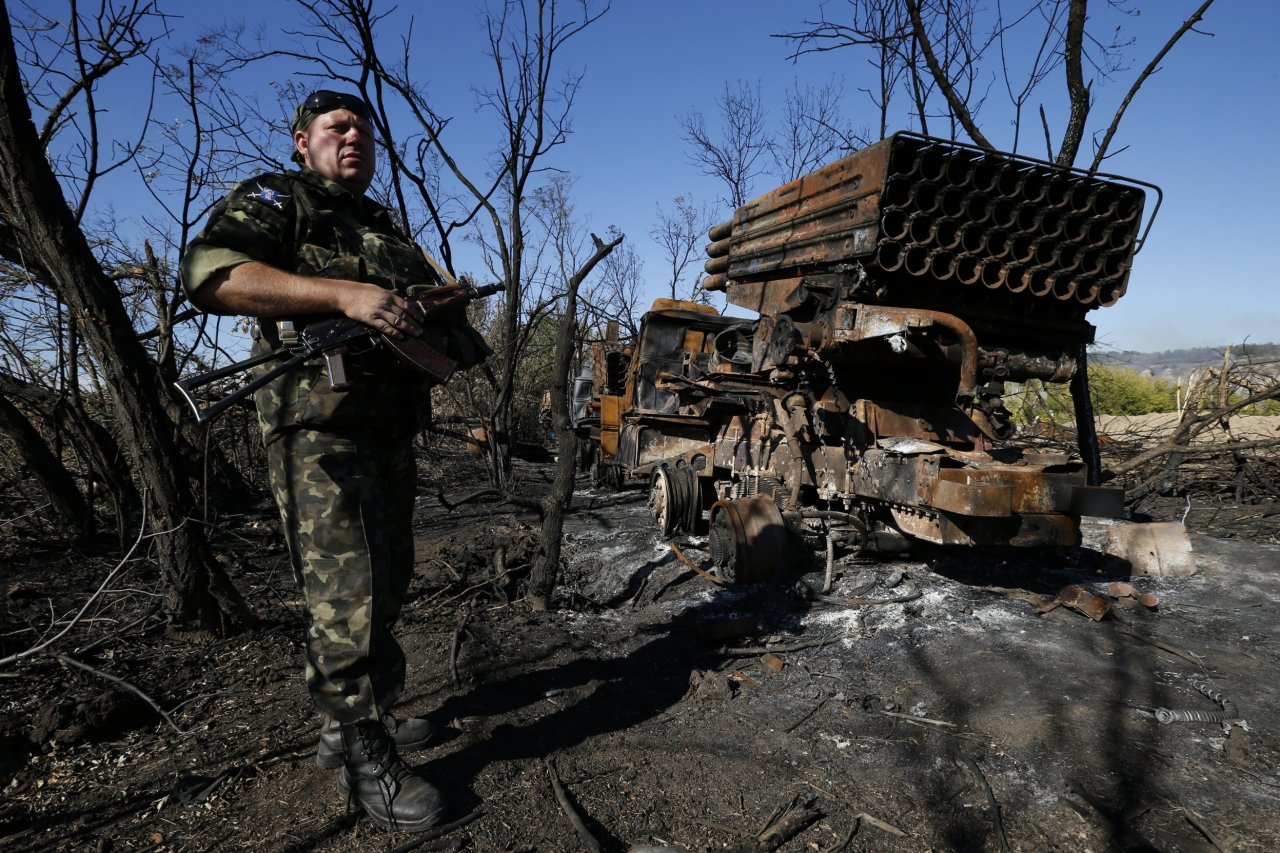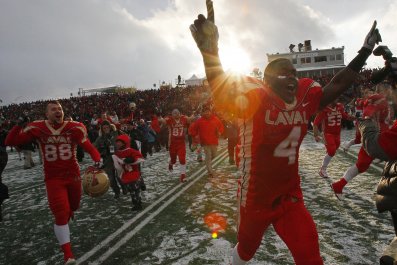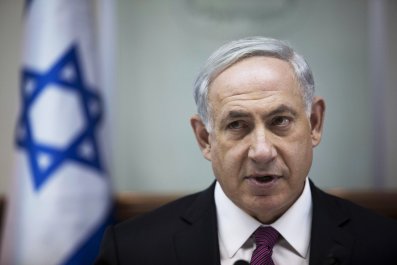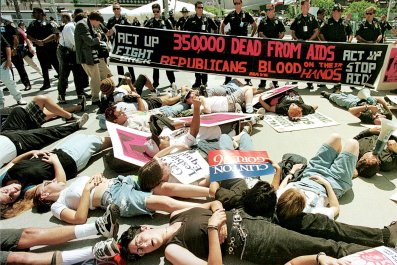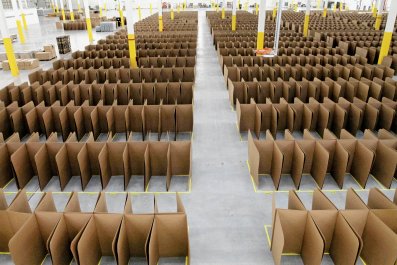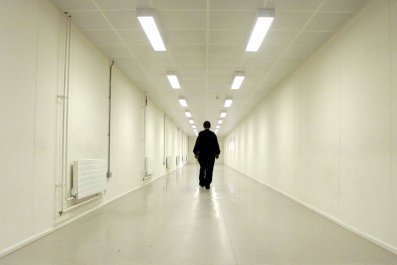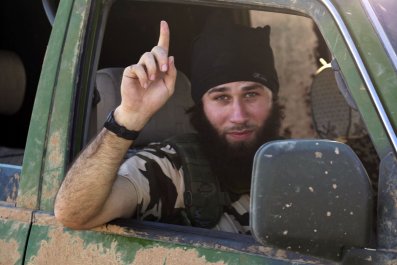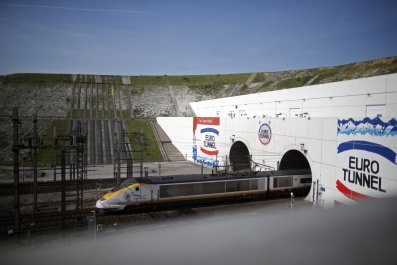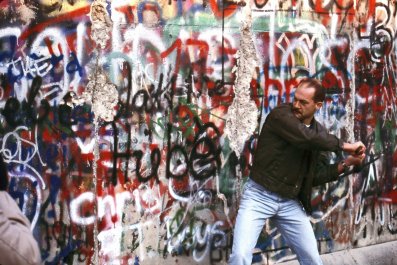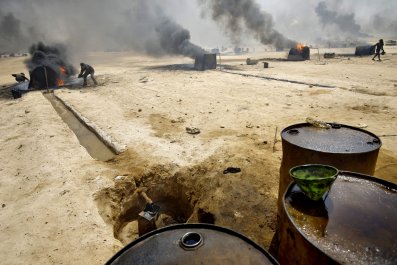Petro Poroshenko, the former chocolate king and recently elected president of Ukraine, stood proudly on the podium in Kiev's Independence Square as 1,500 goose-stepping servicemen, armored vehicles and rocket launchers passed before him.
The military's top brass, decked out in summer dress uniforms and enormous peaked caps, were determined to put on a show for their new commander in chief. Crowds of smiling families in traditional embroidered shirts turned out to wave tiny yellow and blue Ukrainian flags in the summer sunshine. It was August 24, the anniversary of the day the country won its independence from the Soviet Union in 1991.
This year Ukraine's Independence Day carried particular symbolism, since pro-Russian separatists held eastern regions of the country. The celebrations were intended to shore up support for Poroshenko, who three months before had won the presidency as the country risked being torn further apart. Ironically, the Kiev display of military hardware mirrored, in miniature, the annual parades that had rumbled over Red Square in Communist times and have been reinstated by President Vladimir Putin to showcase a resurgent Russia.

Poroshenko promised the crowd imminent victory in his country's proxy war against Russia. Crimea may have been lost without a fight, but eastern Ukraine would be different. "I am confident that the battle for Ukraine, for independence will end in success," he said.
Little did Poroshenko know that 400 miles to the east a catastrophe was unfolding that would become a turning point in the war. The columns of armor Poroshenko said would be sent directly from Independence Square to the front line would hardly be enough to stop a stealth invasion by regular Russian troops.
This report tells in detail for the first time the pivotal events that made up the Battle of Ilovaisk. Reporting from both sides of the hastily drawn border in eastern Ukraine, and hearing evidence from key Ukrainian players and pro-Russian rebels, this account describes the Russian ambush of Ukrainian forces that forced Poroshenko to plead for an immediate cease-fire.
The battle may not be the last in the struggle for Ukraine. But it proved to be a milestone in the country's recent history and brings into sharp focus the covert war Putin is fighting for control over what he calls "Novorossiya" or "New Russia"—a czarist-era designation for southeastern Ukraine.
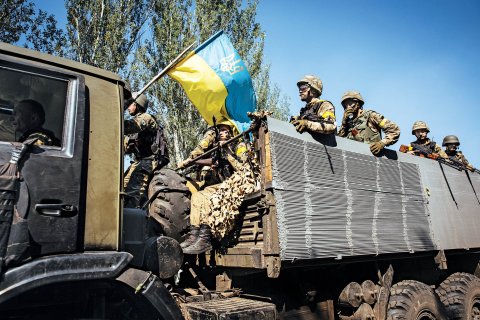
Russian Juggernaut
Even as the parading troops saluted Poroshenko on August 24, alarming reports were reaching the capital that Russian troops, backed by tanks and heavy artillery, were pouring across the eastern border near Amvrosiivka and barreling toward the rail junction at Ilovaisk, where poorly equipped Ukrainian forces had been pinned down by rebels for almost a week.
After months of complaining about commando units and volunteers from Russia backing up the ragtag rebels, Ukrainian officials were dumbstruck in the face of an incursion by the regular Russian army. It took Poroshenko four days to publicly acknowledge the terrible news. By then, several hundred Ukrainian soldiers in Ilovaisk had been surrounded, their rear guard along the Ukraine-Russian border crushed or beaten into a chaotic retreat.
"It was completely unexpected. The Russian forces simply marched in," Lieutenant General Ruslan Khomchak, the commander of Ukrainian forces in Ilovaisk, tells Newsweek. It was hardly a coincidence the Russian advance came to its climax on the 23rd anniversary of Ukraine's declaration of independence from the Kremlin. "The Russians wanted to show us that our independence doesn't mean anything to them," says Khomchak.
That night, Khomchak's command post in Mnohopillya, a farming hamlet four miles south of the besieged town of Ilovaisk, came under Russian mortar fire for four hours. The assault left 10 Ukrainian soldiers dead and the woods around them flattened, the silver-haired general recalls. Khomchak understood that his invisible foe was cutting off his only escape route, but he couldn't obtain permission from the military commanders in Kiev to make an orderly withdrawal. Instead, his troops started making contact with the approaching Russian juggernaut.
Ukraine's lopsided war with Russia began in April, when armed men started seizing administrative buildings in the eastern Donetsk and Luhansk regions. The provisional government in Kiev—swept into office in February after protesters toppled the kleptocratic regime of pro-Russian Viktor Yanukovych—was still reeling from the loss of Crimea, which Russian troops grabbed in the post-revolutionary power vacuum.
Fearful of the country's further dismemberment, the Kiev authorities responded with a clumsy "anti-terrorist operation," only to discover that their security services were demoralized and riddled with Russian informants, while the Ukrainian army was under-equipped and woefully unprepared to counter armed and vicious pro-Russian separatists.
Poroshenko's election as president in May signaled that Ukraine was finally getting its act together. His confidence gave fresh impetus to the fight against the self-proclaimed Donetsk and Luhansk "people's republics," whose ideology is a mishmash of Communist-era slogans, czarist imperialism and Russian Orthodox Church iconography.
In early July, Ukrainian forces retook the transport hub of Slovyansk. On July 17, the shooting down of Malaysian Airlines Flight MH17 over separatist-held territory shocked the world. Circumstantial evidence seemed to indicate that the rebels had accidentally shot down the plane, killing all 298 on board, most of them Dutch nationals. Even Putin showed signs of being taken aback. The Ukrainian military, bolstered by newly formed volunteer battalions, appeared to be on a roll.
While the rebels denied they possessed rockets capable of bringing down a passenger airliner at cruising altitude, their rockets had been devastatingly effective in targeting Ukrainian military helicopters and planes. "It was a de facto no-fly zone, especially along the Russian border," says Oleksandr Danylyuk, a former political activist who now advises the Ukrainian Defense Ministry.
Large swaths of the Russian frontier had already fallen under rebel control, allowing for the unencumbered movement of men and war matériel into the disputed region. Whenever Ukrainian forces approached, they were met by intense Russian artillery fire from across the border, according to officials in Kiev. "The Russians simply set up their cannons and Grad rocket systems and killed our boys from a distance of 20 to 30 kilometers," says Anton Gerashchenko, an aide to Interior Minister Arsen Avakov. "They didn't let us close the border."
By early August, Ukrainian forces were worn out and spread dangerously thin across hundreds of miles of countryside. If they were to seize Ilovaisk, commanders believed, they would be able to cut the highway serving as the Russian supply line to rebels holed up in Donetsk, the regional capital. "Military intelligence made a big mistake," says Gerashchenko, multitasking on three gadgets as he recalls the events. "They said there were very few terrorists and that they were poorly armed. The opposite turned out to be true."
Because there was not enough Ukrainian infantry available to take Ilovaisk, the volunteer battalions Dnipro and Donbas, made up of weekend warriors, were sent in on August 18. The battalions didn't lack fighting spirit, but their original function was to police areas liberated by the army, not to take on a full-scale invasion. "It wasn't our job to attack," says Vyacheslav Pechenenko, 43, a retired police colonel who worked for security in a supermarket chain before becoming deputy commander of the Dnipro Battalion. "It was our first combat experience, but we learned quickly from our mistakes." His unit suffered two dead and eight wounded on the first day.
The two sides fought each other to a stalemate, with the Ukrainians hunkered down to the west of the train line that bisects Ilovaisk, the rebels entrenched to the east—and a terrified civilian population caught in the ferocious crossfire. In the rest of Ukraine, a campaign on social media demanded the Kiev government provide immediate relief for the hapless volunteers stuck in Ilovaisk, but it soon became clear that there were insufficient reserves available to tip the battle in Kiev's favor. The only reinforcements arriving in force were coming to save the rebels.

The Russians Were Lost
On the day of the Kiev parade, Sector D, a Ukrainian defensive line along the Russian border, crumbled as the Russian "rescue force" plowed north toward Ilovaisk. By evening, the town was surrounded. "There were so many Russians that not all of them had maps. The convoy we destroyed had simply gotten lost," recalls Yuriy Bereza, commander of the Dnipro Battalion.
The battle was not all one-sided. The Ukrainians captured two dozen Russian troops in the ensuing skirmishes. Bereza, a 44-year-old grandfather and former army major, says the first Russians he took prisoner thought they were on exercise in Taganrog, Russia: "They were disoriented. They had one allowance of ammunition and rations for a day."
Khomchak says his soldiers captured a T-72B3 tank, used only in the Russian army, fixed it up and started using it against its former owners. When nine captured Russian paratroopers were paraded in Kiev on August 27, Putin, who had strenuously denied that Russia was party to the Ukrainian conflict, was put on the spot.
Putin insisted the Russian troops must have crossed into Ukraine by accident. Meanwhile, reports were coming into Kiev military headquarters that a second column of Russian armor had entered Ukraine at Novoazovsk and was closing in on the port city of Mariupol on the road that links Russia to Crimea.
As the situation grew more dire, frustrations broke into the open between local Ukrainian volunteer police battalions—which answer to the Interior Ministry—and the Kiev military command. On August 28, Donbas Battalion commander Semyon Semenchenko, who had been wounded in Ilovaisk, posted an interview on his Facebook page accusing the central military leadership of abandoning his encircled comrades.
The same day, senior Ukrainian officers on the ground took matters into their own hands. Using a captured Russian radio set, Bereza says he got in touch with Ivan Butkin, a platoon leader from the airborne assault brigade based in Ulyanovsk, Russia, who used the code name Klyon ("Maple"). Bereza offered to release two Russian prisoners—Junior Sergeant Ruslan Akhmetov and Senior Sergeant Arseny Ilmitov—in return for the safe passage of the Ukrainians trapped in Ilovaisk. "We understood that we were surrounded," Bereza says. "We reached an agreement and started preparing our withdrawal."
The same night, Putin intervened, appealing to rebel leaders to give the Ukrainian servicemen "a humanitarian corridor to avoid senseless sacrifices." The Kremlin chief, shielded by a wall of plausible deniability, assumed the role of disinterested peacemaker.
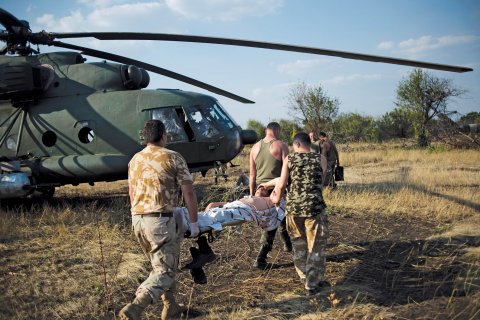
Shooting Gallery
Yet as morning broke on August 29 and the exhausted Ukrainian fighters assembled at the small hamlet of Mnohopillya to withdraw, the conditions for the orderly retreat suddenly changed, Ukrainian officers say. The Russians stalled, providing Ukrainian commanders with a new escape route, demanding the Ukrainians surrender their weapons and suggesting to Khomchak that he leave behind the volunteer battalions, vilified in the Russian media as fascist paramilitaries.
"I said, No, we'll leave as previously agreed," Khomchak remembers. "I don't know how I could have lived with myself as an officer if we'd laid down our arms. I gave the order to march in full battle readiness." With one Russian prisoner of war in each column, the Ukrainians set off along two different roads heading toward Starobesheve, a town about 15 miles away where the official prisoner exchange was to take place.
When his column passed through the first enemy ring, Khomchak says he was amazed to see so many Russian troops. "The woods bordering the fields were swarming with soldiers and armor," he said. The convoy continued along a field road until it reached the outskirts of Starobesheve. "When we passed their second checkpoint, they started shooting at us like in a shooting gallery," Bereza recalls. "It was an ambush."
After the civilian Volkswagen Transporter carrying Khomchak got knocked out, he set out on foot through the fields with Bereza and a dozen other fighters. Hiding by day and walking by night, the men reached Ukrainian lines two days later.
The second Ukrainian column, which traveled out of Mnohopillya on Peace Street, experienced a similar fate. Hundreds of Ukrainian soldiers were dead, missing or captured, and practically all their equipment was destroyed. Officially, 108 dead have been confirmed by the Ukrainian Defense Ministry, but officers fear the number could be four or even six times that once bodies are identified and the missing are confirmed dead.
After the rout of his forces at Ilovaisk and the strategically important city Mariupol under threat, Poroshenko had little choice but to seek an urgent peace agreement with Putin. On September 5, a fragile cease-fire went into effect.
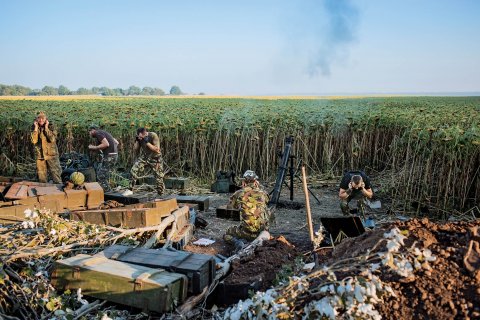
'Ukraine Is History'
A month after the battle, residents of Ilovaisk felt embittered and forgotten after enduring almost three weeks of shelling. At least 100 civilians were killed, according to surgeon Mikhail Golovko, most of them buried where they fell. Homes, the hospital and the school where the Ukrainian military had set up base all bear the scars of bullets and bombs.
"People don't feel they have to follow a president who sent his troops to kill us," says the acting principal, Larisa Chalenko, a petite woman wrapped in an overcoat in her windowless school. "This is an 'anti-terrorist operation'? It's a real war!"
The country road leading to Starobesheve is littered with the remains of vans and burned-out armored personnel carriers with their turrets blown off. Skeletons of trucks stand frozen in fields where their drivers tried in vain to escape. A piece of a rocket, a pile of helmets and a charred pack of cigarettes lie on the shoulder. "We're sorry for those boys," says Alexander Butsan, a local driver. "Nobody knows what either side thought they were fighting for."
The pro-Kremlin rebels who now control Ilovaisk are happy to take credit for the stunning turn of events. The local commander, Mikhail Tolstykh, an excitable, 34-year-old former driver who goes by the nom de guerre Givi, claims Ukrainian forces never even entered the town—contrary to accounts by townspeople, news reports and the storm on Ukrainian social media. Givi says 107 men and a single artillery piece held the Ukrainians at bay, with a little help from a field commander nicknamed Motorola and some Chechen volunteers.
"Ukraine is just a word. It no longer exists. It's history," says Givi, seated behind his desk in the railway police station in Ilovaisk. He says he completed the 11th grade and received his only military training as a conscript in a Ukrainian tank unit outside Kiev. "We're no terrorists. We're the army of the Donetsk People's Republic. I don't give a fuck what others call us."
The gates of his base have been painted in the white-blue-red of the Russian tricolor, and his young soldiers wear "Russia Armed Forces" patches on their fatigues. But when the conversation turns to the negotiations that Ukrainian commanders say they held with Russian officers for the Ukrainians' safe passage, Givi's voice rises.
"What Russian officers? What kind of nonsense are you talking about?" he shouts. "If I have a Russian flag on my armored personnel carrier or on my desk, it doesn't mean that I'm a Russian officer. I respect and love that country and have always supported the policies of Putin and [Prime Minister Dmitry] Medvedev." The only aid the rebels receive from Russia is food, medicine and building materials, Givi says, and all their weaponry was captured from the Ukrainians.
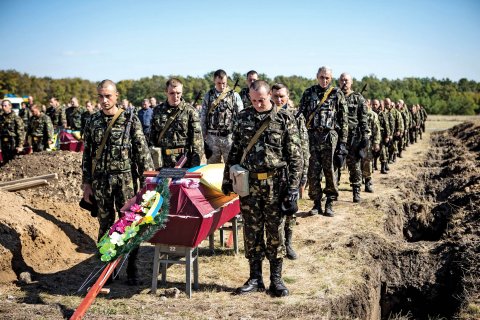
1,200 Russians Dead
The question of Russian involvement has dogged the Donetsk uprising from the very start. Alexander Borodai and Igor Girkin, both Russian citizens, led the separatists' political and military wings until their abrupt departure in August. Alexander Zakharchenko, a local electrician who succeeded Borodai, has conceded that as many as 4,000 Russian volunteers have fought for the rebels, including active military personnel on leave.
Yet if incontrovertible evidence of direct Russian military involvement was hard to come by before the battle at Ilovaisk, the caskets returning to garrison towns across Russia are very real. "In Ilovaisk, 1,000 to 1,200 dead were recorded," says Yelena Vasilyeva, a Moscow-based peace activist who runs a Facebook page that tracks Russian losses in Ukraine. "Most of them were paratroopers from Pskov and Kostroma. They were boys, conscripts, who didn't even know they were going to war."
According to her data, up to 4,000 Russians have been killed or gone missing in the conflict. The number for Ukrainian soldiers is likely twice as high, she says. "A lot is being hidden on both the Russian and Ukrainian sides." Speculation swirls around the actual number of dead, as the Ukrainian Defense Ministry has kept secret the Ilovaisk casualty list.
"If we were Germans, Ilovaisk would be our Stalingrad," says Sergei Ivanov, a blogger who had to flee Luhansk after the separatist takeover.
Poroshenko has pledged to find and punish those responsible for the Ilovaisk debacle, but battalion commanders have already pinned the blame on the top military leadership for worrying more about moving flags on a map than listening to the men on the ground. "The earlier we would have withdrawn, the smaller our losses would have been," says Bereza. On October 12, Poroshenko fired Defense Minister Valeriy Heletey—who had come under intense criticism after Ilovaisk—without giving reasons.
The Defense Ministry's Danylyuk doesn't deny that there were problems in coordination—after all, the Ukrainian armed forces had been neglected for 20 years. He says the Kremlin is behind a media campaign designed to undermine trust in the military and provoke an uprising in Kiev.
Khomchak, the general who refused to surrender, says squabbles about who's to blame ignore the main culprit: "We were betrayed by our eastern neighbor. That was treachery. Without declaring war, they entered our territory and started fighting."
On both sides of the front line, there is little confidence in the shaky cease-fire. The relative lull in the fighting is seen more as a chance to swap prisoners, regroup and rearm to fight another day. Poroshenko himself has admitted that 65 percent of Ukraine's armor was destroyed.
"What kind of cease-fire can there be?" asks Givi. "They signed the cease-fire when they realized that America and Europe didn't give a damn."
A few days ago, his group of separatist fighters took the name "Somalia Battalion" because, Givi says, they are as fearless as Somali pirates. It's clear he's unaware that that broken country is currently in its 25th year of civil war.



